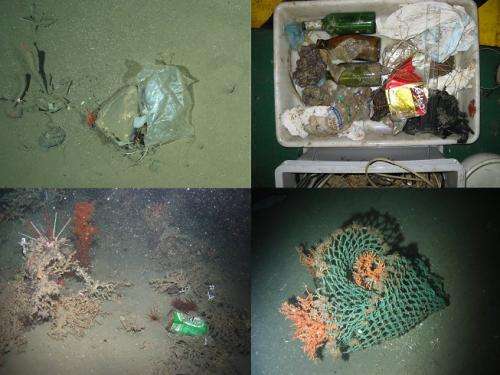Litter now everywhere in the ocean

Litter is now found in even the most remote areas of the oceans, say scientists trying to understand how much rubbish is lying at the bottom of Europe's seas.
The new study, published in Plos One, shows for the first time that there seems to be no area of the ocean left untouched by human litter.
Using 588 video clips collected by unmanned submarine vehicles for geological mapping and marine biology studies, the team found that plastics waste like shopping bags is the most prevalent.
'We didn't focus on specific footage, it came from lots of different studies but we viewed it all. And the biggest surprise was that we found litter everywhere – everywhere we had footage from had been polluted,' says Christopher Pham, a PhD student at the University of Azores in Portugal and lead researcher on the project.
'The majority of what we found was plastic, specifically softer plastics like carrier bags, although we did find other things like pieces of buckets,' he continues. 'We found batteries, part of a plane, pieces of oil drum, shoes, chairs, plastic bottles, clothes, but mostly plastic.'
Research into the extent of marine litter has been done before, but this is the largest single survey to date. The study included 32 sites, which took in some of the deepest and most remote locations around Europe, including the Charlie-Gibbs Fracture Zone between the Azores and Iceland.
At almost three miles deep, this fracture is one of the deepest cracks in the Atlantic Ocean, and one of the most remote. At the bottom of it the team were surprised to find rubbish had even collected there.
'The highest levels of litter were in the submarine canyons, while on the seamounts and around coasts there was less rubbish overall, but what we found was mostly fishing gear,' explains Pham.
The researchers are concerned that short-use items like plastic bags, which are only used for an hour or two at the most, are the biggest culprit in polluting our oceans. If the problem isn't addressed soon, it could cause huge damage.
'It's really about mitigation at this point – clean-up operations are great but governments need to work on preventing the litter getting any worse. The litter is there but the oceans are not completely destroyed yet, but if we continue to pollute them it will send the community into critical levels,' Pham says.
Many studies have already shown the effect tiny plastic particles known as microplastcs have had on sea life, as fish and birds eat them and eventually starve as their stomachs are full of litter.
Pham suggests that this could eventually affect human health, as the seafood we eat may have had a diet of plastic.
'We have to work with children and show them how much plastic has an effect on marine animals; it's not just aesthetic, it's also a problem for health of animals and most importantly the overall functioning of marine ecosystems,' he explains.
'We have to work on our day-to-day usage of plastics. It's a citizen responsibility but at the higher level they need to be stricter too, we should be more rigid,' concludes Pham. 'It's common sense to minimise pollution – to do things like make sure landfills are buried so waste doesn't blow off in the wind into the sea. It's mostly a matter of people being responsible.'
More information: Pham CK, Ramirez-Llodra E, Alt CHS, Amaro T, Bergmann M, et al. (2014) "Marine Litter Distribution and Density in European Seas, from the Shelves to Deep Basins." PLoS ONE 9(4): e95839. DOI: 10.1371/journal.pone.0095839
Journal information: PLoS ONE
Provided by PlanetEarth Online
This story is republished courtesy of Planet Earth online, a free, companion website to the award-winning magazine Planet Earth published and funded by the Natural Environment Research Council (NERC).

















